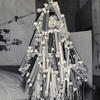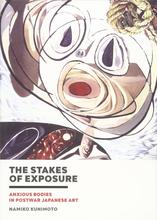More about Electric Dress
- All
- Info
- Shop

Contributor
Tanaka Atsuko's Electric Dress stole the show at the 2nd Gutai Art Exhibition in Takamatsu in 1956, leaving observers thinking, "where did that come from?"
The following year she did an encore performance of Electric Dress at the 3rd Gutai Art Exhibition at Kyoto City Museum of Art. The exact number of electrified components varies widely depending on who's writing about them, so the most accurate estimate is "a whole heap," but Electric Dress consists of the wiring, sockets, and circuitry needed to illuminate approximately one hundred tubes and eighty lightbulbs, which Tanaka coated with nine colors of synthetic enamel paint. It accompanies a series of technical diagrams, such as Drawing for Electric Dress (電気服」に基づく素描), which bear an amazing resemblance to Tanaka's later works in paint, featuring elaborate interconnecting circles and lines, and, in one instance, a work captured in a documentary, in sand on a beach. Tanaka is one of the first to truly understand and apply Marcel Duchamp's performative methods from decades earlier.
To paraphrase the immortal words of the narrator of Ratatouille—not just anyone can be a great artist, but a great artist can come from anywhere. To be exact, Tanaka had traveled, with her husband, collaborator, and right-hand man, Kanayama Akira, from their home in the Osaka area across the archipelago to Kagawa prefecture, which, in those days, was a tall order. She got the idea for the dress from a neon sign, and she wanted it to look like fireworks, or so the story goes.
Getting to Takamatsu with her Electric Dress must have been quite the trip: even today, with the advantage of the enormous, many-part bridge system erected in 1988 which connects Osaka to Kagawa, it takes at least 2.5 hours to drive the distance. The train journey is faster, but costs more than $50, and many of these trains did not exist in 1956. To give you a sense of the vibe of the country in those years, if you're not already aware of the tale: in a rural area south of Kyoto, a young boy named Miyamoto Shigeru had to jump over a series of rocks and logs in order to get to school because the country was still rebuilding its roads. This gave him the idea for the Super Mario Bros. platform-hopping games.
Covering Tanaka's body from head to toe, the Dress has been compared by many critics to a burqa, a garment that covers the entire body, including the face, but Tanaka peers out of it, in the very few photographs of the exhibition. Putting it on, the dress swallowed her up completely, leaving only her hands and face exposed beneath the baroque mass of electrical cords, sockets, plugs, tubes, and glass bulbs. Tanaka recalled: "I had the fleeting thought: Is this how a death-row inmate would feel?" Luckily, she was never electrocuted by her own creation.
At Tanaka's first large retrospective in Tokyo, on February 4th, 2012, organized with a grant from the Japan Ishibashi Foundation, the Museum of Contemporary Art Tokyo showed a 1986 reproduction of Electric Dress.
Sources
- "Atsuko Tanaka's Electric Dress." Commune Daily, https://communedesign.tumblr.com/post/104784306295/atsuko-tanakas-elect….
- 中道淳. "イギリス、スペインを巡回した田中敦子の展覧会が都現美で開催." Feb. 3, 2012, Cinra.net, https://www.cinra.net/news/gallery/6197/2.
- "前衛アーティスト・田中敦子の回顧展「アート・オブ・コネクティング」を東京現代美術館で開催、関連イベントにも注目." Zaikei Shimbun, Jan. 9, 2012, https://www.zaikei.co.jp/sp/article/20120129/93798.html.
- Kanayama Akira and Tanaka Atsuko Association. "「電気服」に基づく素描." 21st Century Museum of Contemporary Art, Kanazawa, http://jmapps.ne.jp/kanazawa21/det.html?data_id=267.
- 清澄白河. "「田中敦子―アート・オブ・コネクティング」展 東京都現代美術館." NekoArena, Mar. 25, 2012, http://nekoarena.blog31.fc2.com/blog-entry-1342.html.
- 浦 典子. "田中敦子-アート・オブ・コネクティング." ARTNEWS, May 4, 2012, https://artnews.blog.ss-blog.jp/2012-05-04.
- 国立文化財機構東京文化財研究所企画情報部. "田中敦子." Tobunken, 2006, https://www.tobunken.go.jp/materials/bukko/28347.html.












